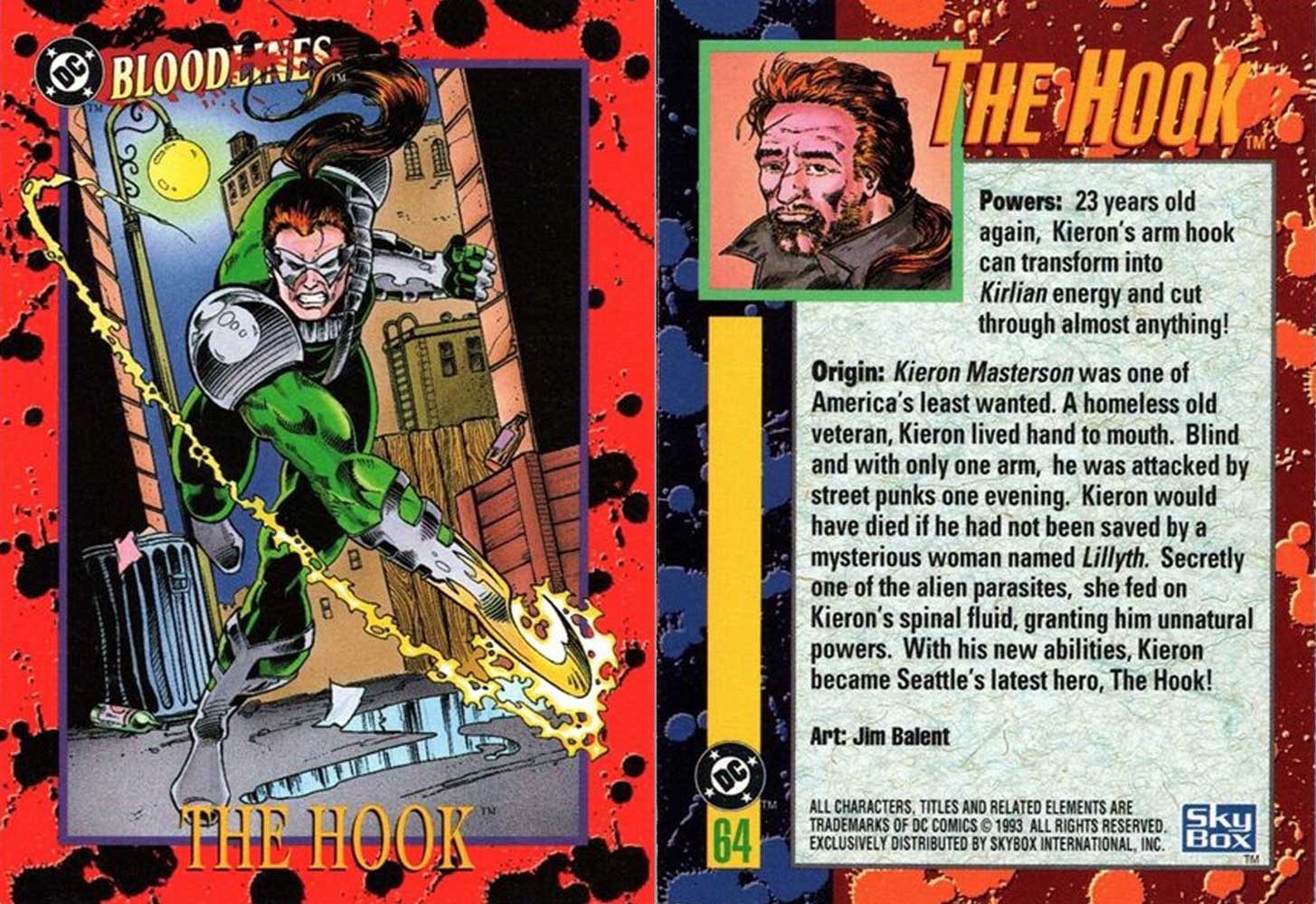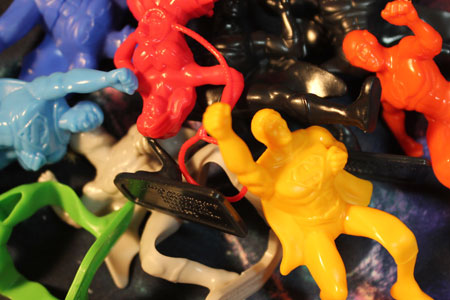It’s May 1993. Superman is dead as of Superman #75 (November 1992), and Batman’s iconic Knightfall arc has just started; two months later he’d have his back broken in Batman #497 (July 1993), throwing the entire foundation of the DC Universe into a tailspin. It’s a weird era of throwing out classic ideas, then seen as outdated, and replacing them with things that are, in retrospect, hilariously edgy. It’s a pouch-covered Batman protege who kills, multiplied by ten. At this point, we’re living in a ’90s superhero name generator where half of the options involve the words “night”, “blood”, “claw”, or “death”.
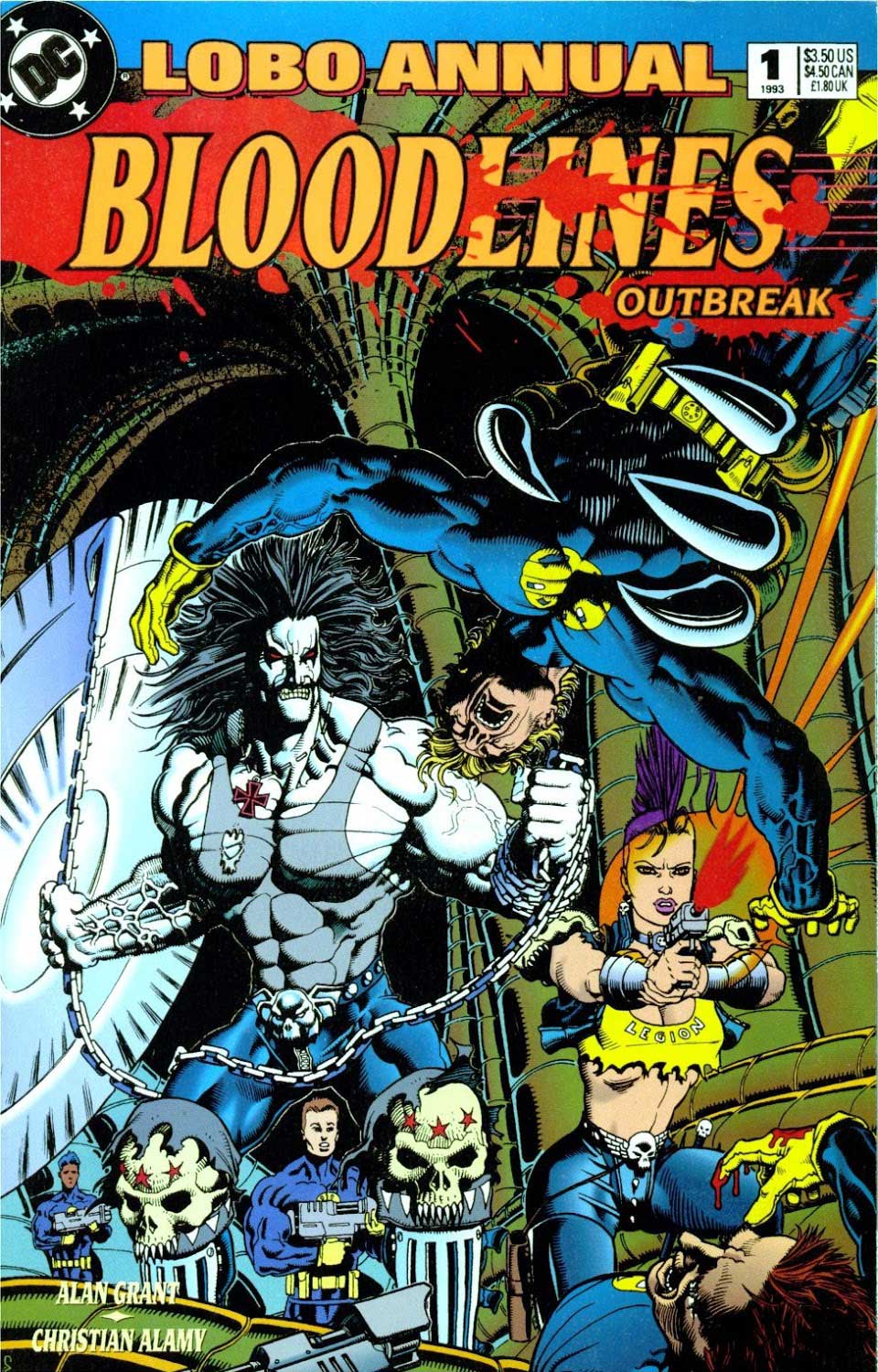
Parallel to the massive events of the Breaking of the Bat, DC Comics also launches a weird label-wide event that would run through the end of the year: an alien gorefest that began in Lobo Annual #1 called Bloodlines. Today, it’s largely forgettable, and almost nothing that came from the event really survives in any notable form in DC continuity, apart from a few cameos thrown in exclusively for the old folks who still remember Bloodlines. Like so many things in the ’90s, it’s a stage to introduce new, always-edgy characters, sell a set of trading cards, and give something big for Cyborg Superman and Jean Paul Valley Batman to do. But was it all bad?
=====
Bloodlines was divided into four phases that definitely weren’t named by someone’s angry kid: Outbreak, Earthplague, Deathstorm, and Bloodbath. Because of the scope of the event, and the fact that it was kind of an outlier to each title’s core stories, every issue of the first three phases is a slightly-more-expensive Annual from 22 different titles.
In Lobo Annual #1, seven serial killer aliens are discovered on a weird space egg, accidentally awakened, and decide to land on Earth to feed. One is killed before they land, but the rest spend all of their time transforming between sexy human forms and giant, grotesque aliens that suck out spinal fluid. For some reason, all seven represent the seven deadly sins, because why not? Because an alien invasion isn’t really enough, it also turns out that whatever mass murdering these aliens do also activates a dormant “metagene” in a bunch of people, who all get powers and decide to fight back against the aliens, alongside our usual cast of heroes.
 And for what it’s worth, Lobo Annual is a good book, drawn stylishly (as Lobo always should be drawn) by Christian Alamy. It’s a wholly appropriate way to kick off what would be a pretty graphic story. Lobo’s characteristic rampant misogyny is checked a few times by Layla, who’s probably the coolest character introduced in the entire series, and she doesn’t even come with a ridiculous name. It’s also the exact era when Green Lantern #54 comes out, and sets the landmark for terrible treatment of women in comics when Kyle Rayner’s girlfriend is killed and stuffed into a fridge. Layla rarely shows up again; once to cut off Lobo’s hand as he’s trying to molest her in a 2-page gag in Lobo #37, and a few more unremarkable appearances.
And for what it’s worth, Lobo Annual is a good book, drawn stylishly (as Lobo always should be drawn) by Christian Alamy. It’s a wholly appropriate way to kick off what would be a pretty graphic story. Lobo’s characteristic rampant misogyny is checked a few times by Layla, who’s probably the coolest character introduced in the entire series, and she doesn’t even come with a ridiculous name. It’s also the exact era when Green Lantern #54 comes out, and sets the landmark for terrible treatment of women in comics when Kyle Rayner’s girlfriend is killed and stuffed into a fridge. Layla rarely shows up again; once to cut off Lobo’s hand as he’s trying to molest her in a 2-page gag in Lobo #37, and a few more unremarkable appearances.
The story continues, seemingly endlessly, after this solid introductory issue. Because this is all happening in a world that’s already been thrown into significant disarray, nobody really puts all of these weird murders together right away, as these aliens seem to move throughout the populated world at lightning speed, sometimes inexplicably appearing in multiple cities at once, probably due to poor plotting on the part of DC Comics. And they do the same thing every time : the find a victim, fight over who gets to drink their spinal fluid, get mad, and fly off to find another victim. Issue after issue. It’s a kind of repetition that’s almost embarrassing, but you keep on reading in case something new actually happens, or the odd chance that DC will introduce a new character that’s actually likable. They don’t, and it all blends into a colorless mush, but they all get their own trading cards regardless.
A guy who can turn a baseball (and other stuff) into a gun. A guy who can throw sharp stuff that comes out of his body. A hook-handed man. This really isn’t even the worst of them. Edge wasn’t even the only villain who had sharp-based superpowers, because there was also Razorsharp, who could make blades out of her arms. And while a bunch of them would team up in 1994 for the Blood Pack 4-issue miniseries, that was pretty much it for most of them. Not that many died, but most were just forgotten.
The series is also possible for the #1 worst Batman panel that ever existed.

But to be absolutely fair, it also has the best Batman panel.

And maybe the best Batmobile.
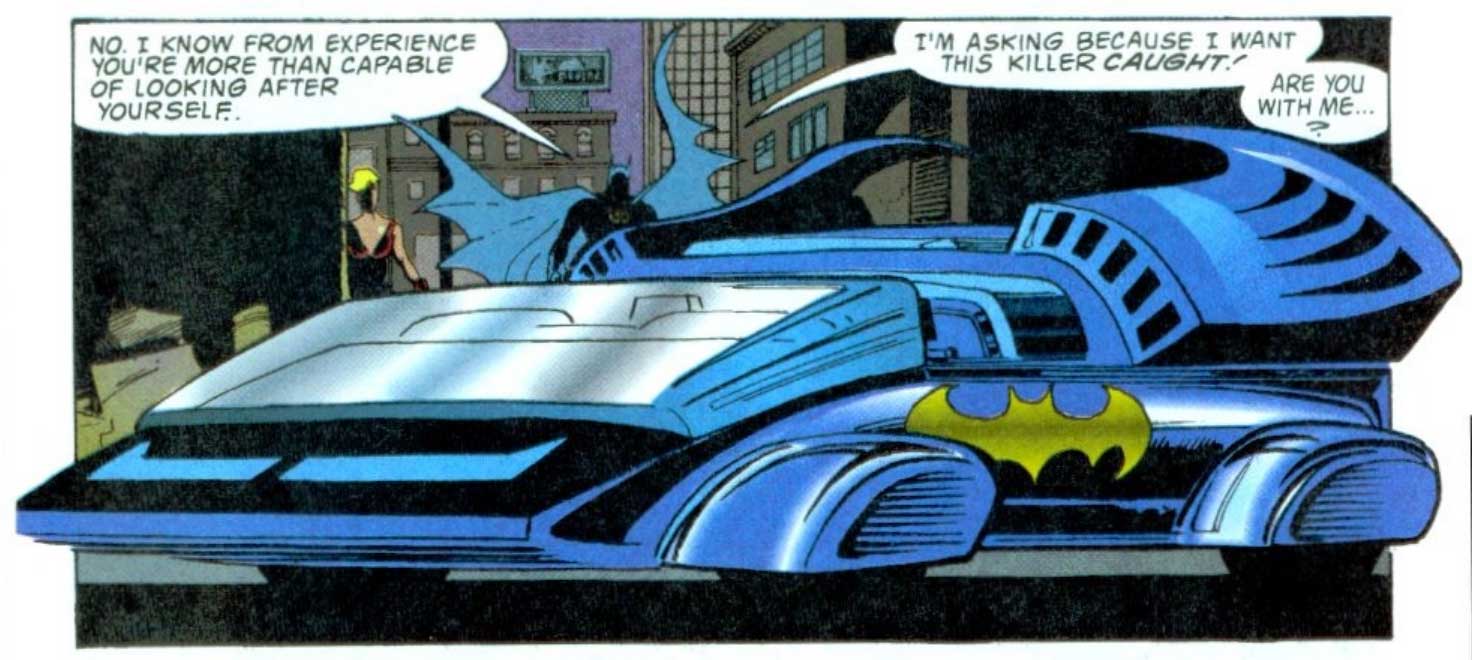
=====
As the series trudges on, there aren’t a lot of memorable moments. The first appearance of right wing cream dream Joe Public is a moment that probably would invite a whole ton of controversy today in a post-9/11 world, but he’s an example of a less careful time when comics were pure, unfettered id, and patriotism wasn’t tinged with as much xenophobia as it is today. It’s not better or worse; it’s just part of the evolution of an art form that has always mirrored the sociopolitical climate of the time.

There has to be a mention of New Titans Annual #9 as not only the worst comic in this whole storyline, but just a bad comic in general. It’s drawn confusingly, it’s plotted confusingly, and everyone is unlikeable. One quippy teenager with anger issues is usually enough for a superhero team, but when everyone on the team has the same prickly personality, it’s not even an enjoyable read.
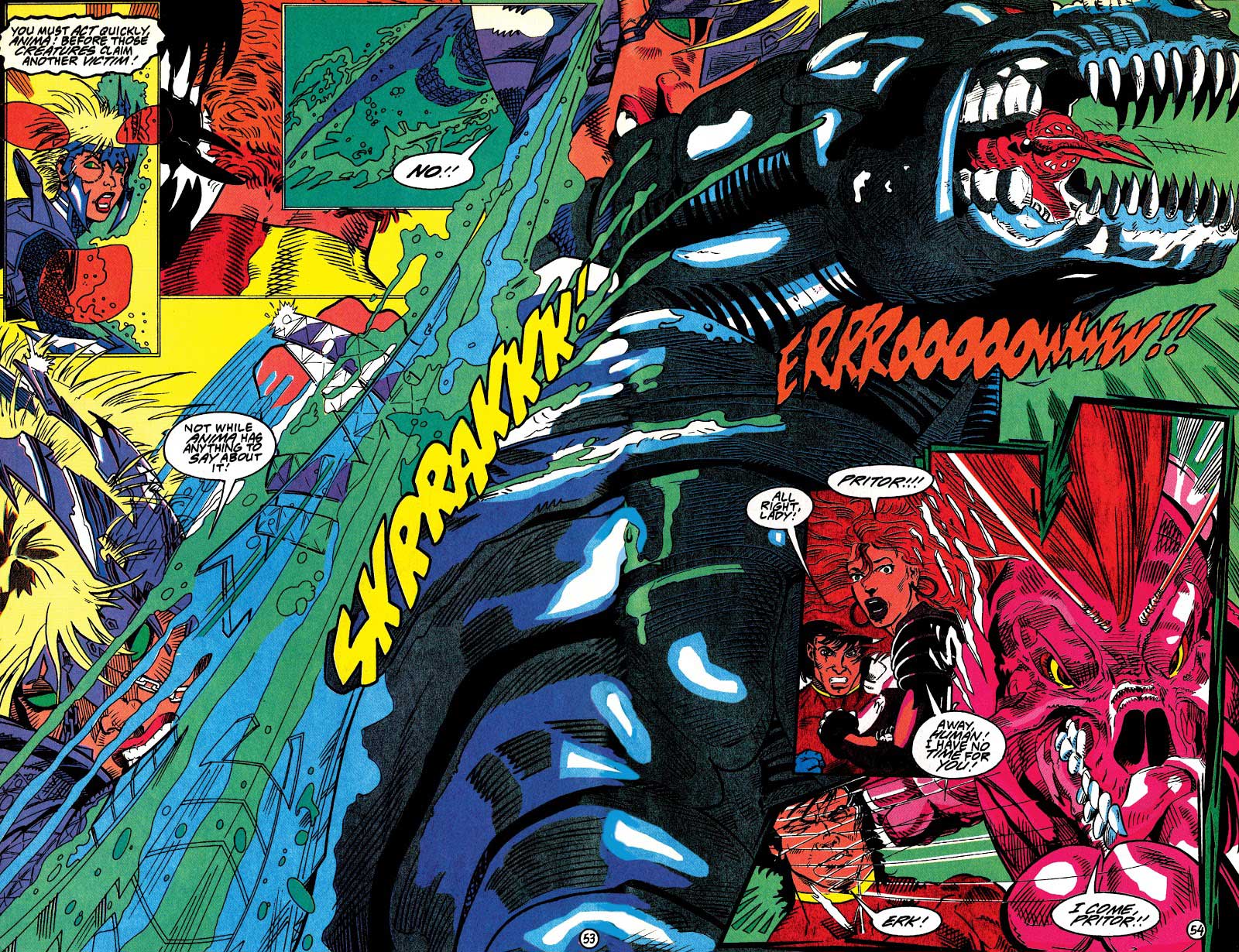
The segment of the story, which introduced the forgettable Anima, takes place in Louisiana, so of course, Swamp Thing has to make an appearance. Normally, that’s cause for celebration, but in this case, he peeks out of the bushes, sees that things are mostly okay, and goes back to sleep. It’s a three panel sequence that’s not even a gag, and doesn’t do much other than to say ‘Swamp Thing exists’. It’s a name drop, like the author does similarly for L7 and Bikini Kill elsewhere in the issue. It’s a ‘look how cool I am’. It’s unintentionally hilarious.

Another standout issue is Adventures of Superman Annual #5, which introduces the semi-obscure Force Family, when Harry and DC Force show up in Suicide Slum with the specific purpose of getting DC bitten by a bug to activate the metagene that runs in their family. (Spoiler : it works.) The whole story is a really clever subversion of the repetition of the preceding issues, and it actually starts to organize the story a little, now that we’re all the way towards the end of the second phase of Bloodlines; turns out that these alien parasites are collecting juices to bring ‘The Taker’ to life. If this purpose was mentioned earlier than this, it’s lost somewhere in the monotony.
When The Taker shows up, during the 2-issue Bloodbath conclusion, it’s a giant Cthulhu of indeterminate purpose, other than to consume and destroy and scream.

All of the heroes get together and try to beat it up, but getting too close makes them stupid. They don’t invite any of the “New Bloods” to the party because they don’t trust them, despite the fact that they’ve been nothing but supportive (but moody), but they show up anyhow, and they’re the only ones who have the power to destroy The Taker. While The Taker is down, DC’s usual heroes throw it into the sun.
And that’s pretty much it.
=====
You’re left wondering why this event existed, but like many things, it seems to have been an opportunity to introduce a slew of characters to be merchandised. But if so, why were they almost immediately abandoned? No action figures, no spinoff collectibles, nothing. Just a set of trading cards. And the Eisner Award-winning Hitman, who was kind of a B-list success, and that’s only because he was written by Garth Ennis.
Anima got a 15-issue series (which also included a #0 issue) that featured a cameo by a recently-dead Kurt Cobain. Argus lasted 6 issues. Hitman spun off into a legitimate series. Most got nothing but weak cameos. As far as creating characters with longevity, Bloodlines was a massive failure. While the villains were always meant to be finite, sacrificing themselves as part of the developing story, it’s unusual that DC made such a minimal effort to continue these new heroes that this whole storyline struggled to introduce. The storyline itself wasn’t really anything innovative; new heroes rising up to defeat the villain who created them is a pretty well-worn trope, and a 2-issue Cthulhu cameo who dies quicker than any of the minibosses isn’t all that original, either. Interspersed are real moments of inspiration, but when you have to dig this deep, it may not be worth the effort. Like making it through all of the Hellraiser movies, it’s an endurance challenge that’s a little fun to power through if you’ve got nothing else going on.
DC made a pretty weak attempt to bring Bloodlines back in 2016 with a 6-issue series that summoned up a bunch of teenagers who gained powers strikingly similar to the original throwaway heroes’ when an asteroid lands on Earth, but that also went nowhere. Even acknowledging the original distracting series was probably a bold move, but there wasn’t really any redemptive arc for the idea, which was now about alien spores instead of the serial killings of sin-themed aliens. By comparison, the ’90s Bloodlines was a masterpiece… and that’s saying something.
All comic images are copyright DC Comics and presented here for the purposes of criticism & commentary.
 C. David is a writer and artist living in the Hudson Valley, NY. He loves pinball, Wazmo Nariz, Rem Lezar, MODOK, pogs, Ultra Monsters, 80s horror, and is secretly very enthusiastic about everything else not listed here.
C. David is a writer and artist living in the Hudson Valley, NY. He loves pinball, Wazmo Nariz, Rem Lezar, MODOK, pogs, Ultra Monsters, 80s horror, and is secretly very enthusiastic about everything else not listed here.



